The Aztec Government and the Triple Alliance
What Was the Aztec Empire?
What we often call the Aztec Empire was really an agreement between three powerful city-states. This team was called the Triple Alliance. It was formed in 1428 by Mexico-Tenochtitlan (the Mexica people), Texcoco (the Acolhua people), and Tlacopan (the Tepanec people).
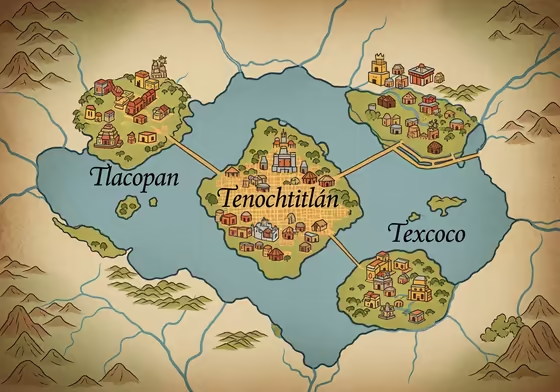
They came together after a civil war to overthrow the ruling Tepanec empire. For nearly 100 years, the Triple Alliance was the main power in the region. They controlled the Valley of Mexico and a large part of central Mexico until the Spanish arrived in 1521.
The Aztecs ruled differently than many other empires. Instead of replacing local leaders, they usually left them in charge of their own city-states. This was allowed as long as the conquered cities did two things: pay tribute twice a year and provide soldiers for Aztec wars.
In return, the empire offered protection and stability. This system was designed to collect wealth and resources from other lands and bring it to the three main cities. This strategy helped the empire grow quickly, but it also made it unstable.
The loyalty of the conquered peoples was based on fear, not friendship. This weakness was used by the Spanish when they arrived. They found many angry groups who were happy to help them defeat the Aztecs.
Aztec politics were also tied to their religion. The rulers, called tlatoque, were seen as having a divine right to rule. Their power was proven through large religious ceremonies.
While conquered people could keep their own gods, they were forced to also worship the Aztec war god, Huitzilopochtli. This was a constant reminder that Tenochtitlan was in charge.
War was a key part of Aztec politics. The empire grew and collected tribute through constant military campaigns. This warfare also served a religious purpose: to capture people for human sacrifices, which were demanded by their state religion.
How the Government Was Structured
The Aztec government was a well-organized system that grew from a small tribe into a powerful empire. It had a clear hierarchy, with a divine emperor at the top and councils that managed the state. Local governments were based on family clans, and a strong legal code kept order.
The Two Top Leaders: The Emperor and His Prime Minister
At the top of the Aztec state were two leaders: the Huey Tlatoani and the Cihuacoatl. This dual leadership divided the huge job of running an empire. One person managed foreign affairs, while the other managed the capital city.
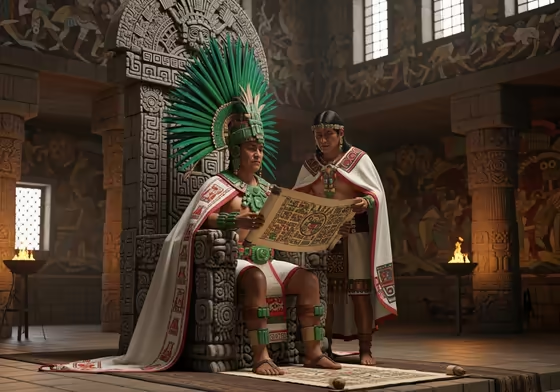
The Huey Tlatoani, or "Great Speaker," was the emperor. He was seen as a god on Earth and had total power over the military, foreign policy, and the tribute system. He personally led armies into battle and managed relationships with other states.
The position of emperor was not passed directly from father to son. When an emperor died, a high council of nobles, generals, and priests elected the next ruler from the royal family. This made sure the new leader was capable.
Before taking power, the new emperor had to prove himself. He would go through religious rituals and then lead a "coronation war." This first military campaign was a test of his skill and served to capture victims for the sacrifices that would mark the start of his reign.
The Cihuacoatl, or "Snake Woman," served as a prime minister. Although the title was female, this position was always held by a man, usually a close relative of the emperor. He was the second most powerful person in the empire.
The Cihuacoatl was in charge of running the capital city, Tenochtitlan. He managed the court system, the treasury, and the government's daily business. This allowed the Huey Tlatoani to focus on expanding and controlling the empire.
The Council of Four
The Huey Tlatoani had a small group of powerful advisors called the Council of Four. This council was made up of four top generals from noble families. They were the emperor's main advisors on war, the economy, and tribute.
The council's approval was needed for any big decision, which helped balance the emperor's power. Importantly, the Council of Four also served as the line of succession. When the emperor died, his replacement was chosen from one of the four members of this council.
Local Government
The basic unit of Aztec society was the calpulli, which was a group of related families that lived in the same neighborhood or district. The calpulli was the key to local government. It managed land, ran local schools, and was responsible for collecting taxes.
Each calpulli was led by a chief called the capullec. He was elected for life by the clan members. The capullec was advised by a council of elders and his main job was to make sure the district's tribute was paid.
The chiefs from all the city's districts formed a city council. This council managed the city and was led by an executive council of four nobles. This structure created a clear chain of command from the family level all the way up to the emperor.
The Legal System
The Aztec state had a strict legal system that covered all parts of life. There was a clear court hierarchy and a set of laws designed to maintain the empire's rigid class structure.
The court system had multiple levels. Small cases were handled in local courts by respected warriors. More serious crimes went to a professional court in Tenochtitlan, and the worst cases were heard in the High Courts at the emperor's palace.
A key feature of Aztec justice was that nobles faced much harsher punishments than commoners. This was a clever form of social control. By holding the elite to a higher standard, the state appeared fair and reinforced the idea that privilege came with responsibility.
For example, a noble could be executed for being drunk in public, while a commoner might only have their head shaved. Nobles were not given second chances, but commoners sometimes were. This sent a message that nobody was above the law.
| Title (Nahuatl) | English Translation / Analogue | Selection / Composition | Primary Domain | Key Responsibilities |
|---|---|---|---|---|
| Huey Tlatoani | Great Speaker / Emperor | Elected by the Council of Four from the royal lineage | Imperial | Supreme commander of the military; oversees foreign policy, diplomacy, and the imperial tribute system; serves as high priest. |
| Cihuacoatl | Snake Woman / Prime Minister | Appointed, typically a close relative of the emperor | Domestic (Tenochtitlan) | Manages the day-to-day administration of the capital city, including courts, treasury, and bureaucracy. |
| Council of Four | High Council / Electors | Four high-ranking military generals from the nobility | Imperial Advisory | Advises the Huey Tlatoani on all state matters; serves as the pool of candidates for the next emperor. |
| Tlatoani | Speaker / King | Elected by a city's executive council from the local nobility | City-State ( Altepetl ) | Rules an individual city-state; manages local affairs and ensures tribute is paid to the empire. |
| Tecuhtli | Lord / High Official | Appointed by the emperor from the nobility ( pilli ) | Provincial / Local | Serve as judges, ambassadors, and local commanders; oversee tribute collection and represent their village to higher authorities. |
| Capullec | District Chief | Elected for life by the calpulli members, confirmed by the emperor | District ( Calpulli ) | Oversees communal land distribution and local tribute collection; represents the district on the city council. |
| Calpixque | Tribute Collector / House Attendant | Appointed officials from the nobility ( pilli ) | Provincial Tribute | Stationed in provinces to receive tribute payments and send reports on agriculture and commerce to the emperor. |
The Lands of the Empire
The Aztec Empire was a mix of directly controlled lands, allied states, and areas under its influence. It was not a single country with clear borders. Instead, it was a collection of provinces and states built upon the main political unit of the region: the city-state, or altepetl.
How Far the Empire Stretched
At its peak before the Spanish arrived, the Triple Alliance controlled a huge territory. It stretched across modern Mexico from the Gulf Coast to the Pacific Ocean. Its influence went as far south as the border of present-day Guatemala.
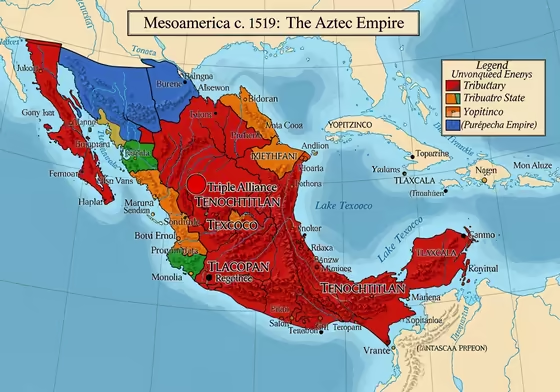
The empire covered about 80,000 square miles and had a population of five to six million people. These people were organized into hundreds of smaller city-states. The heart of this huge empire was the Valley of Mexico, where the capital city of Tenochtitlan was located.
Two Types of Provinces
The empire did not control all its territories in the same way. There were two different types of provinces, each with a different relationship to the Aztec rulers. This flexible approach helped the empire expand quickly.
Most of the empire was made up of 38 tributary provinces. These were areas that had been conquered by Aztec armies. Their main job was to pay tribute, or taxes, to the Triple Alliance.
The empire also had strategic provinces. These were allied states, often located on the borders next to powerful enemies. These provinces agreed to provide military support and act as a buffer zone. In return, they kept more of their own political freedom.
The City-State: The Foundation of Power
The real foundation of political life in the region was the altepetl, or city-state. Each altepetl had its own ruler, its own land, and its own main temple and market. For the people, loyalty was to their own city-state, not to the larger Aztec empire.
The Aztec Empire did not get rid of this system. It was built on top of this network of hundreds of city-states. The Triple Alliance grew by conquering these city-states one by one and forcing them to pay tribute.
This was an efficient way to expand, but it left the empire weak. The Spanish were able to conquer the Aztecs so quickly because they turned these city-states against each other. After the empire fell, the Spanish simply took the Aztecs' place at the top and continued to rule through the existing city-state structure.
Society and Political Roles
The Aztec government was a reflection of its strict social structure. A person's class, usually determined by birth, decided their job, rights, and duties. The empire was run by a noble class, while common people provided the labor and soldiers that kept the empire running.
| Social Class (Nahuatl / English) | Societal Position | Key Political Roles & Obligations | Path to Mobility |
|---|---|---|---|
| Pipiltin / Nobility | Hereditary ruling class. Owned land, exempt from taxes. | Filled all high government, military, and priestly offices. Ran the state apparatus. | Generally closed; born into status. |
| Macehualtin / Commoners | Largest group; farmers, artisans, local traders. | Paid tribute, provided labor for state projects, and formed the bulk of the army. | Military Achievement: Capturing enemies in battle could lead to elevation to "eagle noble" ( cuauhpipiltin ) status. |
| Pochteca / Merchants | Special hereditary class of long-distance traders. | Acted as state-sanctioned spies, gathering military and political intelligence. Had their own courts and guilds. | Hereditary within the merchant class. |
| Tlacohtin / Slaves | Lowest class; debtors, criminals, or captives. | Could be used as sacrificial victims for state rituals. Had certain legal rights; slavery was not hereditary. | Could buy their freedom; children were born free. |
The Ruling Nobles
At the top of society were the pipiltin, the nobles who were born to rule. They controlled the government, the army, and the priesthood. Their power came from their control over land, labor, and the tribute paid by conquered lands.
The Common People
The macehualtin, or commoners, were the largest group of people and the engine of the empire. As farmers and artisans, their main political duties were to pay tribute and provide labor for public projects like temples and roads. Every commoner man was also trained as a soldier from a young age.
Moving Up Through Warfare
Although society was rigid, there was one way for a commoner to move up: by being a great soldier. A commoner who captured a certain number of enemies in battle could be promoted to the noble class. These new "eagle nobles" were given land, titles, and privileges.
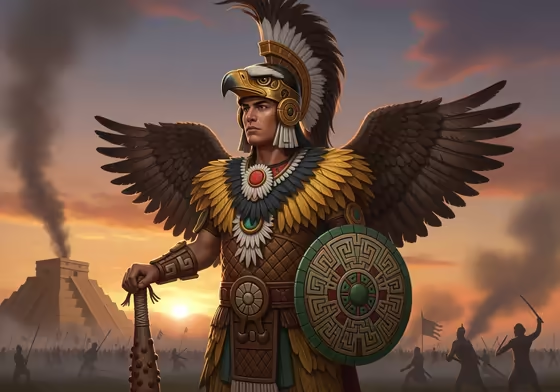
This system was a smart political strategy. It gave commoners a powerful reason to not just fight, but to fight fiercely. The dream of becoming a noble helped make the Aztec military a large and aggressive force.
Special Roles: Priests and Merchants
Two other groups had important political roles: the priesthood and the long-distance merchants.
The priesthood was a powerful class, with the highest positions held by nobles. The high priests of Tenochtitlan advised the emperor himself. Priests also ran the elite schools where the sons of nobles were trained to become the empire's future leaders.
The pochteca were a special class of long-distance merchants. They had their own laws, courts, and gods. More than just traders, they also served as the state's intelligence agency.
On their trading journeys, they gathered information about the wealth and military strength of other cities. This information was used by the emperor to plan future conquests. The murder of a pochteca merchant in a foreign city could even be used as a reason to declare war.
The Empire's Economy
The Aztec Empire's political power was based on a strong economy. The state controlled economic life through a huge tribute system. This government-controlled system existed alongside a busy market economy.
Tribute: The Engine of the Economy
The main engine of the Aztec economy was the tribute system. After a city was conquered, it was forced to pay regular tribute, or taxes, to the Triple Alliance. This was not a one-time payment but a steady flow of wealth into the capital cities.
The amount of tribute was massive. Records show the capital received thousands of tons of food each year. Tribute also included everything from lumber and pottery to warrior costumes, gold, and jade.
This wealth supported the lifestyles of the nobles and paid for government projects. It also supplied the armies for new wars. The tribute system was the key to Tenochtitlan's economic and military power.
Markets and Government Control
The Aztec economy was a mix of a state-controlled tribute system and a free market system. The state did not try to stop private trade. Instead, it regulated it and benefited from it.
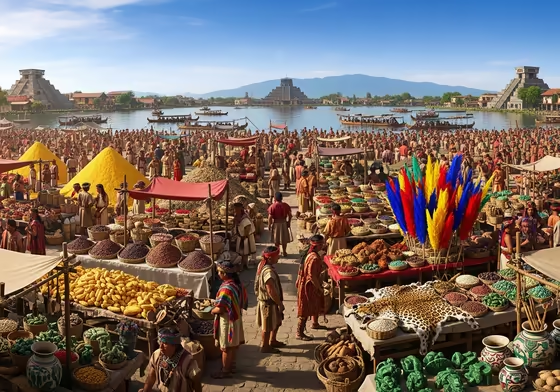
Every Aztec city had a large market, with the one at Tlatelolco being the biggest. Spanish visitors said over 60,000 people gathered there daily. Government officials watched over the markets to ensure fair trade.
The two systems worked together. The emperor would give some of the tribute goods to nobles and military leaders. These elites would then sell their extra goods in the markets, which helped the commercial system grow.
Trade as a Political Tool
The Aztecs used several forms of money. For small purchases, they used cacao beans. For larger ones, they used standardized lengths of cotton cloth called quachtli.
The Triple Alliance used its control over trade as a political weapon. It limited trade between its conquered cities, forcing them to rely on the capital for valuable goods. This prevented them from forming their own alliances that could challenge the empire.
By controlling the flow of high-value items like turquoise and precious feathers, the empire made all major trade routes pass through Tenochtitlan. This made the capital the center of the economic world. It was a powerful way to maintain political control without using military force.
Showing Off Power
The Aztecs used a sophisticated visual language to show their power. Monumental art, architecture, and public ceremonies were all used as state propaganda. These things were designed to prove the ruler's authority, record the empire's history, and scare rivals.
The Codex Mendoza: A Book of Power
One of the best sources of information about Aztec politics is the Codex Mendoza. It was a manuscript created by Aztec scribes about 20 years after the Spanish conquest. It was made to help the Spanish understand their new subjects.
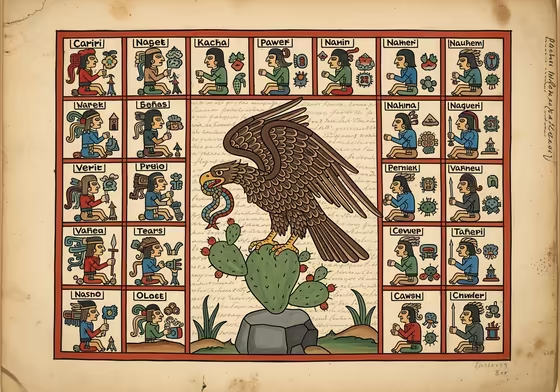
The codex has three sections that visually explain Aztec political life.
- The first part is a history of the Aztec rulers. It shows each ruler and uses symbols to mark the years they ruled and the cities they conquered. This section presents a story of strong leadership and constant military victory.
- The second part is a detailed tribute list. It shows the 38 provinces of the empire and the specific goods each one had to pay. This served as a practical guide for the Spanish on how to collect wealth from the region.
- The third part shows the daily life and customs of the Aztecs. By showing an orderly society with laws and schools, the Aztec authors were making a political statement. They were arguing that their civilization was just as legitimate as the Spanish one.
Buildings and Art as Propaganda
The Aztecs used huge buildings and art to project an image of power. Their public works were a form of propaganda that mixed mythology with real events. This made it seem like their conquests were part of a cosmic destiny.
The best example was the Templo Mayor, the Great Temple in the heart of Tenochtitlan. It had two giant pyramids dedicated to the gods of war and rain, the two sources of the empire's power. Its sculptures told stories that connected the gods' victories to the military victories of the Aztec people.
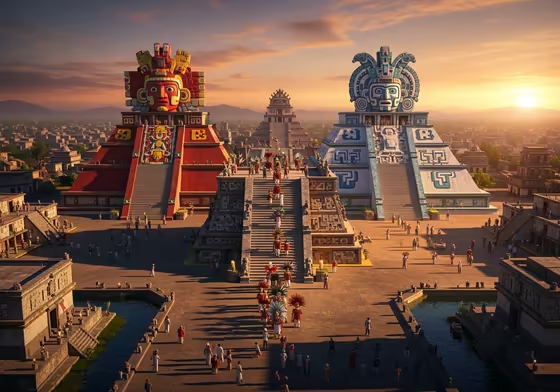
Other large stone sculptures also served as public records of the empire's power. The Stone of Tizoc, for example, shows the ruler Tizoc capturing enemy warriors. These monuments turned military force into divine authority.
Rituals as Political Theater
Public ceremonies, especially human sacrifice, were a form of political theater. These events, often held on top of the Templo Mayor, were a brutal display of the state's power. The victims were usually enemy soldiers, and their sacrifice was a symbol of Aztec military strength.
These rituals were also used as a tool of foreign policy. Leaders from other states were often invited to watch the sacrifices. The message was clear: this is what happens to enemies of the Triple Alliance.
This performance of terror and power was a psychological weapon. It was meant to keep subjects in line and discourage rivals from attacking. Through art, architecture, and ritual, the Aztec state created a powerful visual culture that constantly reinforced its political power.